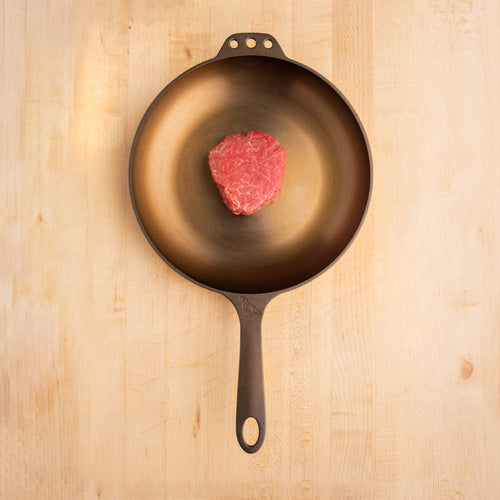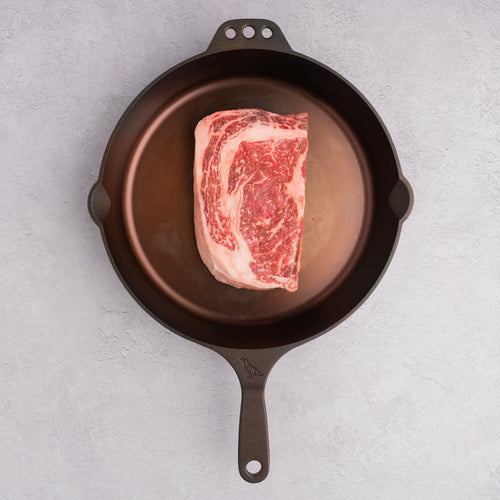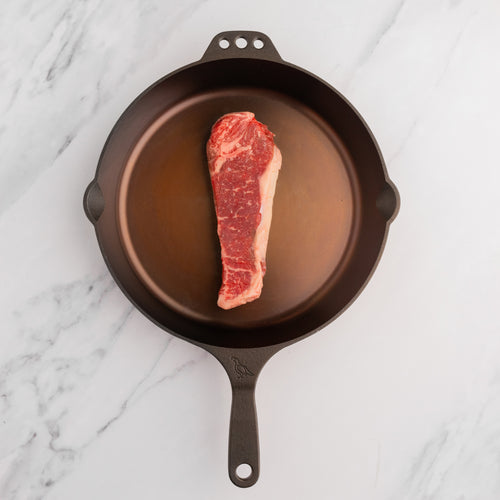
Master the Art of Cooking Steak
Pro Tips for Perfect Results:
There’s nothing quite like a perfectly cooked steak—juicy, flavorful, and seared to perfection. Whether you’re a seasoned pro or just learning how to cook steak, we’ve got you covered. At Snake River Farms, we know that quality beef and the right techniques make all the difference.
In this guide, we’ll walk you through how to cook steak in a pan, on the grill, or using other expert-approved methods to achieve restaurant-quality results at home. Plus, we’ll share pro tips even the most experienced steak lovers might not know. Let’s get started!
|
Table of Contents |
All about Steak: What's the Best Cut for You?
Cooking the perfect steak starts with choosing the right cut. Whether you prefer rich marbling, bold beefy flavor, or melt-in-your-mouth tenderness, we’ll help you find the ideal steak for your taste. Below, we break down the most popular cuts, what makes them unique, and why they deserve a spot on your plate. Ready to cook your perfect steak? Browse our American Wagyu steaks and start your journey to steak perfection today.
Filet Mignon - Buttery Soft and Incredibly Tender
If you’re after a steak that’s luxuriously tender with a mild, pure beef flavor, the filet mignon is the one for you. Also known as the tenderloin, this cut is the most tender steak you can get—so soft you could cut it with a butter knife. It’s lean, low in fat, and has a delicate texture that practically melts in your mouth.
Want to master this melt-in-your-mouth cut? Check out our step-by-step guide on how to cook a filet mignon.

Ribeye - Rich, Juicy and Packed with Flavor
Love a steak that’s loaded with flavor and incredibly juicy? The ribeye is a classic choice. Thanks to its high level of marbling, this cut delivers intense beefy richness in every bite. When cut traditionally, you’ll get a savory layer of fat and the highly prized, flavor-packed cap. If you prefer a boneless option that’s easy to eat, go for the ribeye filet, which comes from the center or “eye” of the ribeye.
Ready to bring out the best in this flavor-packed cut? Learn exactly how to cook a ribeye steak for juicy, steakhouse-worthy results at home.

New York - Bold Beef Flavor with a Firm Bite
Your idea of a perfect steak is one with beefy flavor and firm texture you can really sink your teeth into.
The New York Strip is a steak house classic and is known for good marbling and a strong beef flavor. This is a steak with a definite grain that’s tender, but pleasingly firm to the bite.
If you like a steak with deep beefy flavor and a firm, satisfying bite, you can’t go wrong with the New York Strip. It has the perfect balance of marbling and texture, making it a steakhouse favorite. It’s tender but still has enough chew to give you that classic steak-eating experience.
Want to cook this steakhouse favorite like a pro? Follow our expert tips on how to cook a New York Strip steak for bold flavor and perfect texture every time.

Porterhouse - The Ultimate Two-in-One Steak
Why choose between tender and bold when you can have both? The Porterhouse delivers a Filet Mignon on one side and a New York Strip on the other, separated by the iconic T-shaped bone. It’s a steak lover’s dream—combining the buttery tenderness of the filet with the robust flavor of the strip in one impressive cut.
Want to cook this showstopping steak at home? Get expert tips in our guide to how to cook a Porterhouse steak.

Top Sirloin - Lean Flavorful and Budget- Friendly
Want a steak that’s lean, flavorful, and a great value? The Top Sirloin is a fantastic choice. It’s packed with bold beefy taste, has a satisfying chew, and costs less than premium cuts—without sacrificing flavor. If you love a hearty, no-frills steak, this one’s for you.
Looking for big flavor on a budget? Learn how to cook a Top Sirloin steak for a satisfying, no-fuss steak night.

Flat Iron - Well-Marbled, Tender and Affordable
If you’re looking for a steak that’s tender, well-marbled, and easy on the wallet, the Flat Iron is a hidden gem. Sometimes called a top blade steak, it comes from the shoulder (chuck) section and is a favorite among butchers for its rich beefy flavor and surprisingly tender texture. It’s a great alternative to more expensive cuts while still delivering incredible taste.
Ready to try this underrated favorite? See our guide on how to cook a Flat Iron steak for rich flavor and perfect tenderness at home.


Steak prep: How to Get Your Steak Ready for Cooking
Proper steak prep is essential to ensure even cooking and a delicious result. Here are the steps you need to take to get your steak ready for the heat, so you can cook it to perfection.
- Allow Your Steak to Reach Room Temperature: Take your steak out of the fridge 30 to 60 minutes before cooking. Starting with a room-temperature steak helps it cook more evenly. If it’s too cold, the outside will cook much faster than the inside.
- Pat Your Steak Dry: Before cooking, use paper towels to pat your steak dry. Moisture on the surface can prevent a good sear, so drying it off helps create a crust that locks in flavor. Working with a thicker cut? proper prep is key—learn how to cook a thick steak without overcooking it.
- Season Simply: A simple seasoning of salt and pepper is often all you need. Season generously on both sides, and let it sit for about 10–15 minutes. This gives the salt time to penetrate the meat, enhancing its natural flavor.
- Preheat Your Cooking Surface: Make sure your grill, pan, or oven is preheated before placing the steak on it. For grilling, get the grill to a high heat. If pan-searing, heat the skillet until it’s very hot—this helps create the perfect sear. Looking for more ways to improve your sear? Explore our guide to getting a perfect crust on your steak.
- Optional: Lightly Oil the Cooking Surface: If you’re using a pan, a light coat of oil can help prevent sticking and ensure a smooth sear. Use an oil with a high smoke point, like avocado or beef tallow.
5 Steak Cooking Methods
Each method we cover is designed to help you cook your steak to perfection. Below, you’ll find step-by-step instructions for each technique and a video guide for visual learners.
Method #1: Steak House
The classic way to prepare a steak up to 1.5" thick.
1. Season
Heat a heavy skillet over medium-high heat until hot. Add a light coat of vegetable oil to the skillet. Season steak with salt and pepper.
2. Sear
Place steak in hot skillet and sear for 4 minutes, turning once. If a steak sticks to the skillet, it’s not ready to turn. Wait until it releases on its own.
3. Cook
Place skillet in a 350°F oven for 10 to 20 minutes depending on desired doneness. Turn once halfway through. Remove when your preferred internal temperature is reached.
4. Rest
Remove from skillet and cover loosely with foil. Let rest 5 to 10 minutes as it continues to cook and temp rises about 5°F.
Watch the video to see the Steakhouse method in action:
Method #2: Searing
A fast and easy way to cook steaks 1.25” or thinner.
1. Season
Heat a heavy skillet (cast iron preferred) over medium heat. Add a light coat of oil. Season top side of steak with salt and pepper.
2. Sear
Place steak seasoned side down. Sear 4 to 5 minutes until browned. Don’t flip until it releases naturally.
3. Flip
Turn over and cook 3 to 5 more minutes. Use a thermometer after 2–3 minutes to check doneness. Remove and serve.
Check out the video for the Searing method:
Method #3: Reverse Sear
This method starts with a low-temp bake, then finishes with a high-heat sear for a beautiful crust—ideal for thick steaks.
1. Season
Preheat oven to 275°F. Season steak with salt and pepper. Place on a rack over a foil-lined pan.
2. Cook
Bake until steak reaches your desired temp. For medium-rare, aim for 120°F. Start checking after 30 minutes.
3. Rest
Remove from oven and let rest 10 to 15 minutes under foil.
4. Sear
Sear in a hot oiled skillet for 60 to 90 seconds per side to finish.
Want to learn more about the reverse sear method? Check out our detailed guide for step-by-step instructions and expert tips on achieving the perfect steak every time.
Watch the Reverse Sear technique here:
Method #4: Sous Vide
Precision cooking for consistent doneness every time.
1. Heat Water
Use an immersion circulator to bring water to your target temp.
2. Season
Generously season both sides of the steak.
3. Package & Seal
Use a vacuum-seal bag or submerge a zip bag with a small air opening to remove air. Seal completely once submerged.
4. Cook
Place in the water bath for 1–3 hours depending on thickness and preferred doneness.
5. Heat Skillet
Heat a heavy skillet over medium-high with a light oil coating.
6. Sear
Remove steak from bag, pat dry, and sear 1–2 minutes per side. No need to rest—serve immediately.
See how to cook sous vide here:
Method #5: Direct Grilling
Perfect for steaks 1.5″ or thinner when cooking outdoors.
1. Season
Preheat grill to medium. Oil grates and season steak with salt, pepper, or rub.
2. Sear
Place on grill for 2 minutes. Lift, turn 45°, grill another 2 minutes.
3. Flip
Repeat sear and turn process on the other side. Total time for medium-rare: ~8 minutes. Use a thermometer to check doneness.
4. Rest
Remove from heat and tent with foil for 5 minutes. Add finishing salt before serving.
Watch the Direct Grilling Method in action:
Steak Temperature Guide: How to Achieve Your Perfect Doneness
Here are the magic numbers you’ll need to determine when your steak is cooked to the degree of doneness you most prefer. The internal temp is when the steak should be removed from the heat. The steak will continue to cook so the temperature will rise during the rest period. Ensure perfect doneness every time. Shop our premium steak boxes or grab a reliable meat thermometer today.
| Preference | Description | Internal Temp. |
|---|---|---|
| Rare | Red, cool center | 110°F |
| Medium Rare | Red, warm center | 120°F |
| Medium | Pink throughout | 130°F |
| Medium Well | Primarily grey, sliver of pink | 140°F |
Are you a visual learner? See our short video “Cooking Steak to the Perfect Temp and Doneness".
Our Favorite Steak Recipes
If you’re looking for inspiration beyond traditional steak cooking methods, we’ve got you covered. These tried-and-true recipes highlight the natural richness of Snake River Farms steak while incorporating bold flavors and unique preparations. Whether you prefer a classic preparation or something a little more adventurous, these recipes will elevate your steak experience.
- Filet Mignon with Tallow-Seared Mushrooms and Onions
- Wagyu Ribeye Filet with Beet Risotto & Herbed Goat Cheese Cream Sauce
- Steakhouse Ribeye: Restaurant Steaks at Home
- Suya-Dusted Bone-In Ribeye
- Sous Vide NY Strip with Truffle Butter
- Porterhouse Surf and Turf with Garlic Lemon Caper Sauce
- Sirloin Steaks with Charred Leek Gremolata
- Flat Iron Steak with Warm Garlic and Blue Cheese Sauce
These recipes highlight the incredible flavor and quality of Snake River Farms steaks. Whether you’re cooking for a special occasion or just want to elevate your steak game, these dishes are sure to impress. Enjoy!
FAQs: Quick Tips
What are the best cooking methods?
There are several great ways to cook a steak, but some of the most popular methods include:
- Pan-searing - cooking a steak in a pan over high heat for a crispy crust and juicy center.
- Grilling - Using an open flame or gas grill for a smoky, charred flavor.
- Reverse-searing - Slow-cooking the steak first and then searing it in a pan for a perfect crust.
- Sous Vide - cooking the steak in a temperature-controlled water bath before finishing with a quick sear.
How to cook steak in a pan for the best results?
To cook steak in a pan, follow these steps:
- Let it rest at room temperature – About 30-45 minutes before cooking.
- Preheat your pan – Use a cast-iron or heavy-duty skillet and heat it over high heat.
- Use high smoke-point oil – Avocado oil or vegetable oil works best.
- Sear the steak – Cook for 3-4 minutes per side, flipping once.
- Check for doneness – Use a meat thermometer for accurate results.
- Rest before slicing – Let the steak rest for 5-10 minutes to lock in juices.
This method gives you a perfectly browned crust while keeping the steak tender and flavorful.
What is the best way to check steak doneness?
The most accurate way to check steak doneness is by using a meat thermometer. Insert the thermometer into the thickest part of the steak without touching bone or fat.
Here’s a quick temperature guide:
- Rare: 110°F
- Medium-Rare: 120°F
- Medium: 130°F
- Medium-Well: 140°F
- Well-Done: nope
For an extra tip, let your steak rest for about 5-10 minutes after cooking to allow the juices to redistribute.
Want a deeper dive? Check out our article, The Best Steak Cooking Tip - Take the Temperature.
Conclusion: Master the Art of Cooking Steak
Cooking the perfect steak is all about choosing the right cut, seasoning well, and mastering your cooking method. Resting and slicing properly enhance flavor and tenderness.
Need help selecting tools and gear? Explore our Grilling Essentials guide for everything you need to grill like a pro. With these tips, you can achieve steakhouse-quality results at home.
Ready to get started? Shop premium steaks at Snake River Farms.







